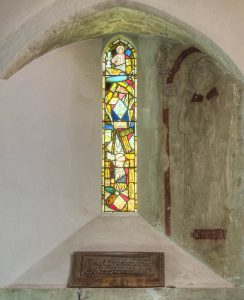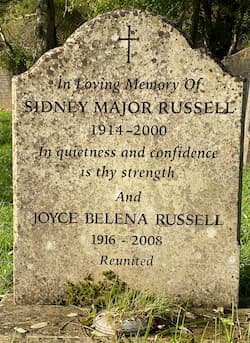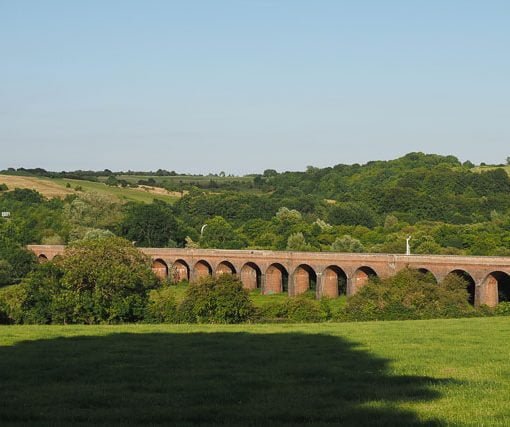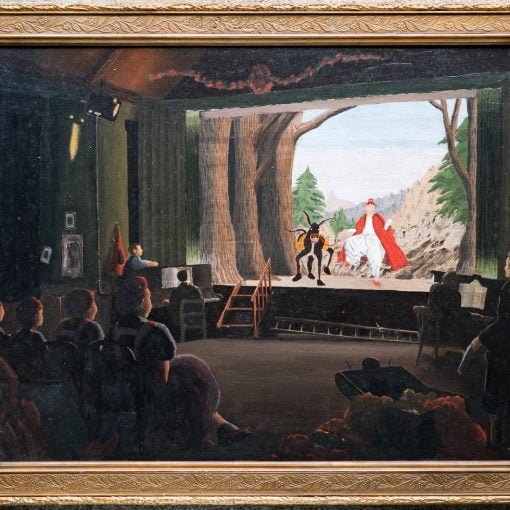Compton Parish Magazine July 1930
By the courtesy of Miss Escombe and the Editor of the Nursing Times, the magazine contains this month a charming Article entitled “Broken Lights.” The Church referred to is Compton. The Article was first published in 1911.
Broken Lights

possibly Thomas Becket
In the chancel of an old country church may be found a narrow, lancet-shaped window, upon whose splay is traced the figure of a Prior or Bishop, his head surmounted by a nimbus, his right hand holding the staff of office. For many years the window was blocked from sight. Its very existence had, indeed, passed out of knowledge, until, during some restoration when the walls were cleansed of plaster and whitewash, scraps of colour seen accidentally led to a search for the lost treasure. Window and painting thus both came to light.

The opening was subsequently filled with broken bits of glass, remains of an earlier east window, which torn down and shivered to atoms after the ruthless manners of other days, had given place to a newer subject. Of design, there is none. The fragments are very small, and had been cast aside to go on the dust-heap. Yet here gleams a spot of crimson, there run the lines of some snapped angle; whilst a letter, a thistle, a group of leaves rouse a curiosity that cannot easily be satisfied.
The whole makes a strange medley, though it is kept from incongruity by the harmonious blending of the old colouring. In contrast with these broken bits, this piece-meal of odds and ends guileless of unity or association, the fragments are unexpectedly crowned by a perfect likeness. Above the tokens of defacement, of spoliation, of careless oblivion, like some tender tribute of remembrance, just where the stone-work curves round to the apex of the arch, is inserted a peculiarly faultless, though very diminutive, three-quarter representation of the Saviour. Untouched, unmarred, remarkable for its exceeding benignity and peacefulness, the expression that rests upon the face might almost be called a smile. To complete its dignity, the head is encircled with a “glory”, consisting of four triangular clusters of rays, a symbol used at times to denote the presence and sympathy of the Trinity. Within the uppermost triangles stand the abbreviated forms of the sacred monogram IHS and XP.
This small figure depicted in act to bless is shown with the right hand uplifted and two fingers extended. Covering the heart a largely drawn letter A commemorates the eternal Alpha – “Christ the beginning, as the end is Christ.”
The beautiful embodiment, in spite of its little size, rises over the fragments beneath, and, with remarkable tranquillity transfigures their desultory intention. The influence which binds them together seems to convey a lesson on life.
Life, as known to each one of us, with its entanglements, its perplexities, its confused, unfinished aims, its unworthy schemes, is built up of fragments. Throwing now a light, now a shadow, its myriad endeavours, its myriad failures, its ignorances and lack of definite purpose nowhere touch completeness. Its best efforts too often only lead to some result far enough away from the wished-for goal, the original objective. Looked at by themselves, these scattered attempts disappoint. They are simply a patchwork of imperfection, a jumble of parts, in some measure fulfilling a use, but fulfilling it without that recognised beauty which springs from unity and consecration.
To be saved from the sense of overwhelming futility, of waste or loss, life demands an indwelling sovereignty greater than its own petty creativeness. The conscious presence, the power and stay of a spiritual unity alone brings redemption to a crumbling incompleteness, leads “from man’s dust to God’s divinity.”
Earth’s “broken lights” may still be left, but their purpose is changed and revolutionised. Beneath the crowning glory of the perfect whole, each separate undertaking is drawn together and set fast. The life that holds the Christ enshrined sheds a new radiance and meaning. The glow of its sanctification streams beyond the criss-crossing and shortcomings of the individual will, reveals its larger destiny, points the sway and stimulus of an end faintly understood. This presence, where it exists, not only diffuses an atmosphere of faith and hope, but is able through love to link life’s unprized fragments, to assure—
That nothing walks with aimless feet;
That not one life shall he destroyed,
Or cast as rubbish to the void,
When God has made the pile complete.
MABEL ESCOMBE
This article is reproduced unaltered from the July 1930 issue of the Compton Parish Magazine, though the photos were taken in 2018.
We are indebted to the Hampshire Records Office, who retain copies of most past issues since 1928 in their archive (under reference 1M76/PZ)




